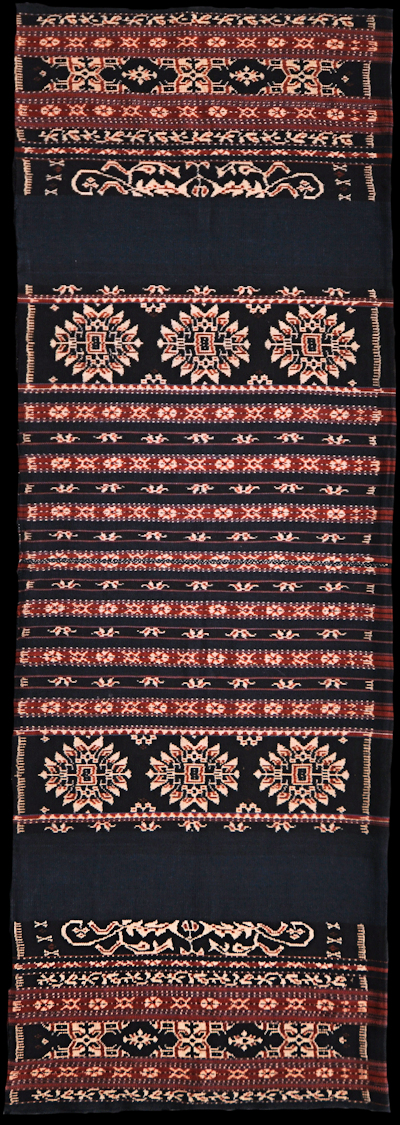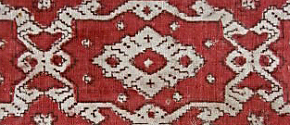| |
 
 | | | |
255 Savu Group, Savu
Ei (sarong)  
| | Locale: | Hubi uki moiety. | | Period: | 1940 | | Yarn: | Cotton, hand-spun, fine | | Technique: | Warp ikat | | Panels: | 2 | | Size: | 115 x 165 cm (3' 9" x 5' 4") LW: 1.43 | | Weight: | 530 g (18.7 oz), 279 g/m2 (0.91 oz/ft2) | | Design: | Ei worapi, a type that may be worn by both moieties, woven by Hubi Iki weaver. Two wide bands called hebe with bunga lehu (lehu flower) pattern in ecru on dark indigo, two wide bands in indigo called medi ae (big black). Numerous narrow bands with a variety of patterns including boda. Wide end sections with seven bands called wuru mada. The outermost of the widest of these bands, called lane bella, are decorated with the woke janga motif; the innermost, the lane wo na iki, with a floral motif. The blue ridges of the seam in the middle mark this as a sarong made by a weaver of the Hubi Iki moiety. The unusual motif in the second widest ikated band is very similar to that seen on PC 176, and is likely to have been inspired by the same rare type of Indian trade cloth - either a patola, or a basta, a block-printed copy. | | Comment: | [PHOTOGRAPHY PROVISIONAL] Older example of over-overage quality. The drawing of the complex patterns is very tight. While the main motif in the hebe, the widest ikated band, is traditional, the floral patterning is of European inspiration, showing the influence of Dutch needlework patterns brought to the island by the wives of Protestant missionaries and Ambonese schoolteachers. Sarong was opened up, cloth is shown here folded over. Another Savu sarong that we suspect of carrying an emulation of the same type of basta is PC 136, which also exudes high class.
Below is a detail of 17th-18th C. chintz sarasa with VOC trade stamp.
 | | Background: | Chapters on Savu Group and Savu. | | Compare: | 009 028 185 136 | | Sources: | Identical hebe pattern shown on photo of weaver preparing dyed warp for weaving in Miep Spee, Een taal van draden unpublished manuscript, 1989, Fig. 44. Similar, in terms of overall type and quality of ikat work to ei depicted in Khan Majlis, Woven Messages, Fig. 437 but here with traditional triple repeat of traditional motif, rather than a European inspired floral motif. European inspiration is seen most clearly in the second widest ikat bands. | | |

©Peter ten Hoopen, 2025
All rights reserved.
|
|


